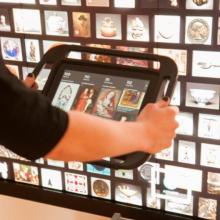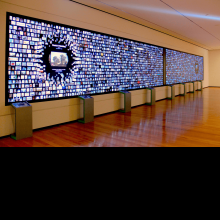I’m privileged to work for Zenith Systems, LLC as a software developer for A/V automation systems. We provided the design, installation, and technical support for the Cleveland Museum of Art’s new Gallery One. One of the focal points of this space is the Collection Wall, a 40-foot wide multi-touch wall composed of Christie MicroTiles, running custom software by Local Projects to explore the museum’s collection of artifacts.
In order to make the experience even more interactive, visitors can check out an iPad from the museum or get an RFID tag for their own iPad, dock it at one of eight stations along the wall, and select items from the wall to add to their personalized tour. These saved items are then accessible from the iPad so they can find them as they explore the rest of the museum’s collections. While communication to the iPad is done via wireless, we needed a way to seamlessly identify which iPad was interacting with the wall, and at which of the eight podiums. RFID was an obvious choice, but the next question was how we could prototype and then integrate RFID technology into this one-of-a-kind project.
I was asked to research possible solutions, and I identified two major categories of solutions: we could use a commercially-available badge reader/door access security system, or we could design and fabricate our own PCBs, antennas, and so on. The first solution was not appealing because security manufacturers don’t tend to be the most open bunch, and I knew we could run into problems with getting the information we needed out of their systems, especially since we weren’t using them in traditional ways – for instance, we wanted to know when an iPad was still present, and when it was removed from a dock. The second solution would have been difficult as well since we have little in-house experience with custom electronics.
I was pleased to find Parallax’s solution as a middle ground: pre-assembled, ready to go, but with full access to the information coming back from the RFID sensor. I picked up two of them and made a mock-up to demonstrate that the RFID tags could be stuck to the back of an iPad or iPad case, and could be read reliably through a piece of frosted plexiglass. The prototype worked so well that we used the readers for the finished project. Each of the eight podiums includes a Parallax RFID Card Reader connected via USB back to a PC. That PC talks to the 8 readers and reports the detected IDs to the two super-powered workstations that drive the graphics for the 40-foot multitouch wall.
The largest technical challenge will be familiar to anyone who has dealt with FTDI devices and COM ports on Windows – while we could assign a device to a specific COM port, it wouldn’t stay there reliably. If the USB hubs were powered up in a different order, or if the phase of the moon was wrong, Windows would detect the readers as new devices and assign new COM ports to them. The solution that’s in place now uses Win32 APIs to enumerate all of the FTDI USB devices and identify them by serial number rather than relying on Windows to assign ports repeatably.
Cleveland Museum of Art - Gallery One


